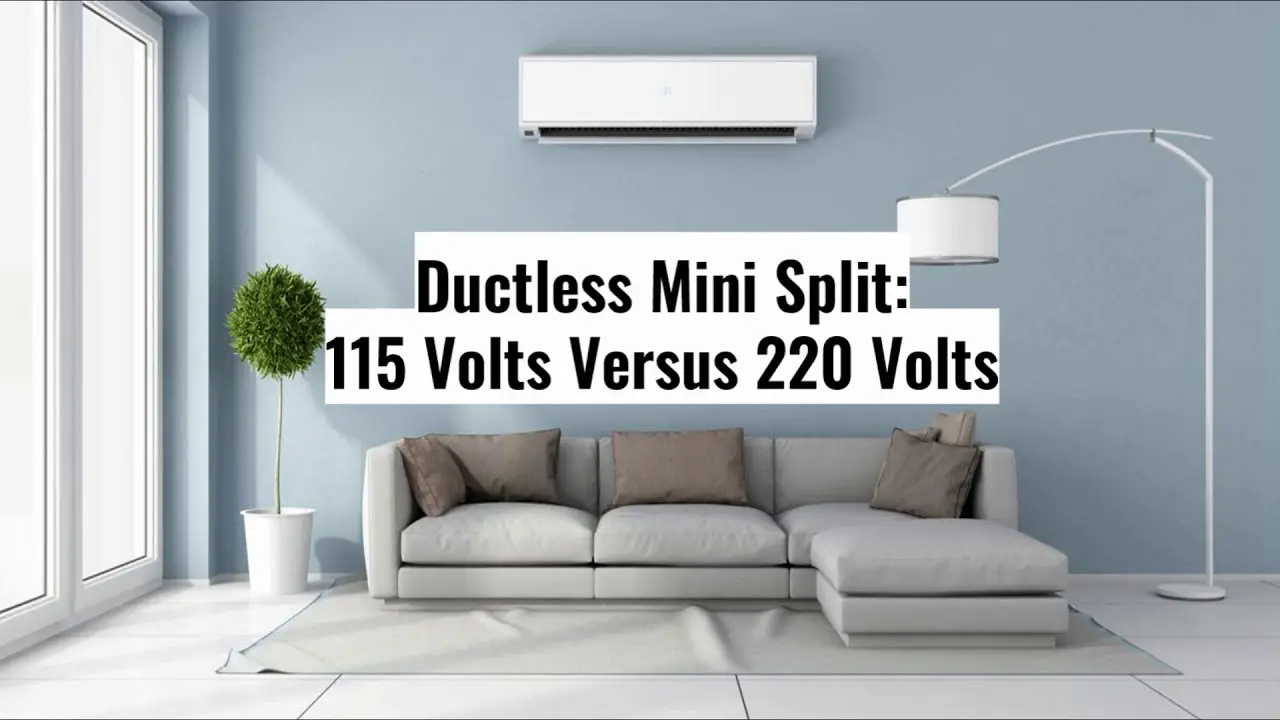110V mini split systems are suitable for small spaces, while 220V mini split systems are ideal for larger areas. The voltage you choose should be based on the size of the space you need to cool or heat.
110V mini splits are energy efficient and cost effective for small rooms, but 220V mini splits offer higher cooling and heating capacities for bigger areas. When considering a mini split system for your space, it’s important to understand the difference between 110V and 220V options.
110 Vs 220 Mini Split
110 and 220 mini-split, it’s important to consider the differences in voltage requirements. A 110 mini-split operates on standard household voltage, while a 220 mini-split requires a higher voltage. This variance has a direct impact on energy consumption and efficiency. Generally, a 220 mini-split is more energy-efficient, but it may require additional electrical work during installation to accommodate the higher voltage. On the other hand, a 110 mini-split is easier to install but may consume more energy. Understanding the installation considerations for each type is crucial to making an informed decision. Take into account the existing electrical setup and potential long-term energy savings when weighing the pros and cons of 110 vs 220 mini-split systems. |
110 Volt Mini Splits
110 vs 220 mini split systems, it’s important to understand the common scenarios for 110v mini split usage. These systems are suitable for smaller spaces, such as individual rooms or tiny houses, where 220v electrical service may not be available. Opting for a 110v mini split has its pros and cons.
One advantage is the ease of installation and lower cost, but they may have limitations in terms of heating and cooling capacity. Key features include their energy efficiency and compact size, making them ideal for certain applications.
However, it’s important to consider their limitations in terms of overall output and potential restrictions in larger spaces.
220 Volt Mini Splits
220 volt mini splits offer several advantages over their 110v counterparts. The higher voltage enables the units to handle larger cooling and heating loads, making them ideal for larger spaces and commercial applications.
Additionally, 220v models generally have higher energy efficiency, resulting in lower long-term operating costs. In situations where increased power and performance are crucial, such as industrial settings or large residential properties, 220 volt mini splits are the preferred choice.
When comparing power capabilities and performance, 220v units outperform 110v models, providing faster and more effective climate control. The ability to handle larger capacities and operate more efficiently makes them a superior option for meeting demanding cooling and heating needs.
110 Vs 220
110 Vs 220 Mini Split systems are a popular choice for homeowners seeking energy-efficient heating and cooling solutions. When comparing the SEER ratings, it’s essential to consider the energy efficiency of both systems.
While 110V mini splits may have a lower initial cost, 220V systems often offer higher energy efficiency, resulting in potential long-term savings. Additionally, the sustainability aspects of each voltage option must be taken into account, as 220V systems may offer greater environmental benefits due to their increased efficiency.
Ultimately, careful consideration of the SEER ratings and long-term cost benefits can help homeowners make an informed decision when investing in a mini split system.
Installation And Wiring Demands
When it comes to choosing between a 110V and 220V mini-split, it’s essential to consider the installation and wiring demands. While a 110V mini-split may require standard wiring, a 220V unit demands a dedicated circuit with a higher voltage capability, necessitating professional installation to ensure efficiency and safety.
110v mini split systems require a dedicated electrical circuit with proper wiring and an appropriate breaker. It is important to hire a professional to ensure the system is installed correctly and safely.
On the other hand, 220v mini split systems have higher electrical demands and may need a dedicated circuit with heavier gauge wiring. Professional installation is highly recommended for these systems due to the complexities involved.
While it is possible to attempt a DIY installation for 110v systems, 220v systems require professional expertise. It’s important to carefully consider the electrical infrastructure and the potential challenges before deciding whether to install a mini split system on your own or seek professional assistance.
Mini Split Maintenance And Upkeep
When it comes to maintaining a mini split system, it is essential to understand the differences between 110v and 220v units. Troubleshooting common issues for both voltage types is crucial for efficient operation.
Regular maintenance, including cleaning filters and checking for leaks, is necessary to ensure a longer lifespan and reduce the frequency of servicing needs. Paying attention to the power requirements and usage patterns can also impact the maintenance and upkeep of the mini split systems.
By understanding these differences, homeowners can effectively maintain and prolong the lifespan of their mini split units.
Cost Analysis For 110 And 220 Mini Splits
When considering the cost analysis for 110 and 220 mini splits, the initial investment comparison is a crucial factor. Initial cost for a 110 mini split tends to be lower due to its lower voltage requirements, while a 220 mini split may involve a higher initial investment due to its voltage needs.
However, examining the operating cost over time for each voltage is equally important. Although the initial investment for a 110 mini split may be lower, the operating cost may be higher in the long run compared to a 220 mini split.
Furthermore, it’s essential to consider the potential rebates and incentives available for each voltage. Some regions offer incentives or rebates for installing energy-efficient systems, which may help offset the initial investment and long-term operating cost.
Frequently Asked Questions For 110 Vs 220 Mini Split
What Are The Differences Between 110 And 220 Mini Split Systems?
Mini split systems operating at 110 and 220 volts have differing power requirements and cooling capacities. 110V systems are suitable for smaller spaces and are more energy-efficient, while 220V systems are ideal for larger areas and offer higher cooling power.
What Factors Should I Consider When Choosing Between 110v And 220v Mini Split Systems?
When choosing between 110V and 220V mini split systems, consider the size of the space, energy efficiency, cooling capacity, and the electrical wiring available. Determine the specific cooling needs of the area and ensure the electrical infrastructure can support the chosen system.
Are 220v Mini Split Systems More Energy-efficient Than 110v Systems?
Yes, generally, 220V mini split systems tend to be more energy-efficient compared to their 110V counterparts. This is because they are designed for larger spaces and require less energy to achieve the desired cooling effect, resulting in better efficiency and lower overall energy consumption.
Conclusion
The choice between a 110Vs220 mini split system depends on your specific needs. Evaluating factors such as space, energy efficiency, and cost will help in making the right decision. Both systems offer unique advantages, so selecting the one that aligns with your requirements is crucial for optimum comfort and savings.

